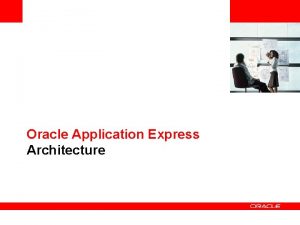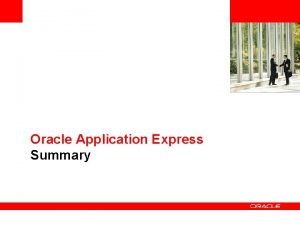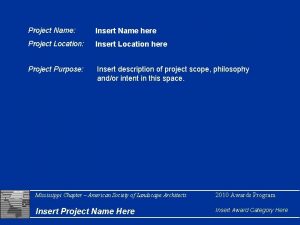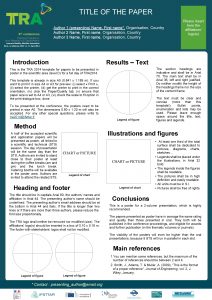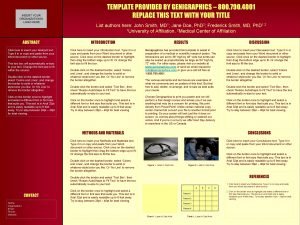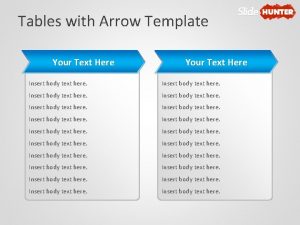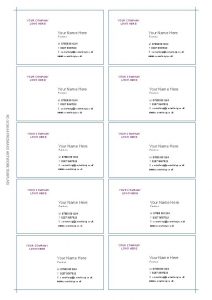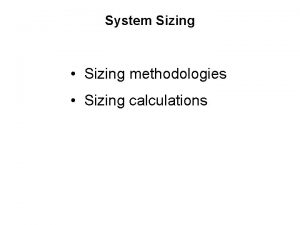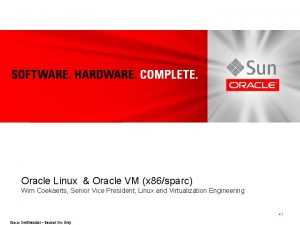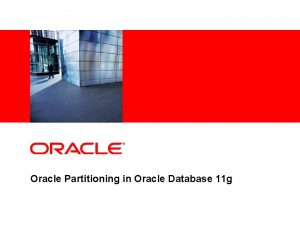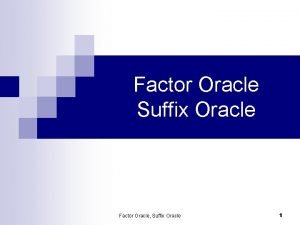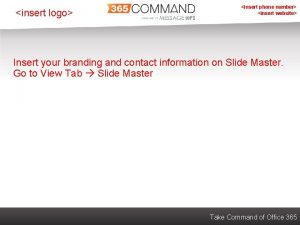Insert Picture Here ASCP Hardware Sizing Oracle VCP





















- Slides: 21

<Insert Picture Here> ASCP Hardware Sizing Oracle VCP PMO

Purpose: This document provides an overview of ASCP hardware sizing tool, sizing inputs, and calculations & assumptions used in hardware sizing. It is intended solely to derive a rough estimate of hardware requirements for an ASCP implementation. Disclaimer: This document in any form, software or printed matter, contains proprietary information that is the exclusive property of Oracle. Your access to and use of this confidential material is subject to the terms and conditions of your Oracle Software License and Service Agreement, which has been executed and with which you agree to comply. This document and information contained herein may not be disclosed, copied, reproduced or distributed to anyone outside Oracle without prior written consent of Oracle. This document is not part of your license agreement nor can it be incorporated into any contractual agreement with Oracle or its subsidiaries or affiliates. This document is for informational purposes only and is intended solely to assist you in planning for the hardware required for ASCP implementation and Oracle is not responsible for the inaccuracies caused by data or by the tool to come up with the estimates. The analysis represents an estimate based on generally observed performance and research. Estimate results are not to be adopted as a guarantee, but as one input from the system to be validated by a robust testing program. . © 2009 Oracle Corporation – Proprietary and Confidential 2

• • • Supported Configurations Sizing Tool Overview Sizing Inputs Explanation of Sizing Inputs with Examples Sizing Calculations & Recommendations © 2009 Oracle Corporation – Proprietary and Confidential 3

Supported Configurations One Machine Architecture EBS and Planning Server on one machine © 2009 Oracle Corporation – Proprietary and Confidential 4

Supported Configurations Two Machine Architecture EBS Server ASCP Database + concurrent manager node Planning Server © 2009 Oracle Corporation – Proprietary and Confidential 5

Supported Configurations Three Machine Architecture ASCP Concurrent Manager (4 CPU cores, x GB RAM) EBS Server VCP Database Server (4 CPU cores, 8 -10 GB RAM) Planning Server © 2009 Oracle Corporation – Proprietary and Confidential 6

Sizing Tool Overview • Sizing tool is intended to create a rough estimate of hardware requirements for Oracle’s ASCP Product The output includes • Recommendation for RAM memory. • Recommendation for number of CPU Cores needed • Disk Space • The sizing output represents and estimate of the hardware requirements and architecture within the limits of design “best practice”. The results are to be used as guidance. Analytical iterations are required, considering the functional model, data used to generate a more accurate output. These iterations should be tasks on the critical path of the implementation plan. Oracle is not responsible for the inaccuracies caused by data or by the tool to come up with the estimates • Sizing and the resulting architecture design should be reviewed as the project matures. Early in the project, requirements and estimates are more uncertain than they will be in later lifecycle phases. There are many variables that can affect performance in the system used to deploy ASCP. Throughout the project lifecycle iterations of testing are required to confirm the performance suggested by the inputs, system components and user loads. Data used for testing should be a close approximation of the real production data as possible. © 2009 Oracle Corporation – Proprietary and Confidential 7

ASCP Sizing Inputs 1. Customer/Company Name 2. Requestor’s E-mail address 3. Industry Segment 4. # of Daily Buckets in Plan Horizon 5. # of Weekly Buckets in Plan Horizon 6. # of Period Buckets in Plan Horizon 7. ASCP Plan Type 8. Number of Inventory Organizations 9. Items enabled in each inventory organization 10. Number of Demand lines in entire Plan Horizon 11. Average Order modifiers across all the organizations 12. Average Demand Quantity 13. Average number of levels in Bill of Material 14. Average number of components in an end assembly 15. Average number of operations 16. Number of resources © 2009 Oracle Corporation – Proprietary and Confidential 8

Explanation of Sizing Inputs • Customer Name • Provide the name of the Customer/Division for which sizing is being done • E-mail address • Provide the e-mail address of the requestor. Sizing results will be posted to this email address. • Industry Segment • Choose the industry segment of the customer, Hi. Tech, Retail, CPG, Etc. The sizing tool has a list of values. © 2009 Oracle Corporation – Proprietary and Confidential 9

Explanation of Sizing Inputs Cont’d… • ASCP Plan Type § § § Specify the planning type for ASCP plan (The sizing tool has a list of values). Based on the project objectives and goals, select the correct ASCP plan type. ASCP can run : Unconstrained Constrained Optimized Constrained with decision rules For the constrained plan with decision rules or the optimized plan, the sizing tool will generate an exception “Invalid No. of Daily Buckets “ if, daily buckets > 90 or the total buckets > 130. This is a warning to the requestor the plan may be excessively constrained. Please contact apspmo_ww@oracle. com to continue. © 2009 Oracle Corporation – Proprietary and Confidential 10

Explanation of Sizing Inputs Cont’d… • Source Application Please provide the primary source of Planning data. Note: If source ERP application is JDE-E 1, then 20% additional disk space is needed at database server (i. e. disk space recommended by sizer + 20%). This additional disk space is needed to store data in temporary tables required by JDE-VCP integration. © 2009 Oracle Corporation – Proprietary and Confidential 11

Explanation of Sizing Inputs • Daily Buckets In Plan Horizon • Specify the number of daily buckets in the plan’s horizon. § The time buckets in Oracle ASCP are used to create plans that simultaneously provide long range aggregate planning and short term detail scheduling. § As the number of daily buckets greater, the time to calculate a plan will increase. Note: To reduce the computational effort to calculate a plan, and to reduce the volume of plan output (for clarity), the horizon should be set only as large as is necessary to capture the critical detail. © 2009 Oracle Corporation – Proprietary and Confidential 12

Explanation of Sizing Inputs Cont’d… • Weekly Buckets in Plan Horizon § Specify the number of weekly buckets in the plan. In case of weekly buckets, the dates for supplies and demands are reported at the end of the last working day of the week. Weekly buckets can only start on the week beginning day from the manufacturing calendar. If the daily horizon does not end on the day before a week beginning day, the planning engine extends it to the next day before a week beginning day • Period Buckets in Plan Horizon In ASCP period patterns are defined not months. For periods you need to choose 4/4/5 weekly pattern (i. e. first period is of 4 weeks) or the 5/4/4 weekly pattern as the quarterly calendar type. © 2009 Oracle Corporation – Proprietary and Confidential 13

Explanation of Sizing Inputs Cont’d… • Number of Inventory Organizations • Specify the number of inventory organizations to be included in the plan. • Items enabled in each Inventory Organization • Average active items for planning in an inventory organization • Specify the average number of MRP Planned Items across all Inventory Orgs. For example: § If Organization 1 has N 1 planned items and Organization 2 has N 2 planned items you need to provide the simple average of the two ((N 1 + N 2)/2). © 2009 Oracle Corporation – Proprietary and Confidential 14

Explanation of Sizing Inputs Cont’d… Items enabled in each Inventory Organization Note: ASCP does not plan the items having the MRP planning code “Not Planned”. We should only plan for items which are critical to our supply chain, and mark all other items as “Not Planned”. This will help reduce the plan size and increase performance. There is a validation check in the sizer that will throw and exception if the number of item-organization combinations (number of inventory organizations * items enabled in each organization) exceeds one million. The exception is, “'Invalid Item Org Count. ”. The sizing tool will not give an output. If the entries are correct and > 1 Million, then contact apspmo_ww@oracle. com to continue. © 2009 Oracle Corporation – Proprietary and Confidential 15

Explanation of Sizing Inputs Cont’d… • Number of Demand lines in entire Plan Horizon Specify the total number of independent demand lines (forecast + sales orders) in entire planning horizon. If the specific numbers are not available early in the implementation, you can derive the number using history from the execution system. Add additional buffer for growth. If the number of demand lines is more than 1 million, an exception will be raised “Invalid Demand Line Count”. Contact apspmo_ww@oracle. com to continue. • Average Order modifiers across all the organizations Provide an input of average lot sizes (considering order modifiers such as minimum order quantity, fixed order quantity etc). This can be a approximate number. This input along with average demand quantity helps in determining the number of supplies created by planning engine. © 2009 Oracle Corporation – Proprietary and Confidential 16

Explanation of Sizing Inputs Cont’d… • Average Demand Quantity Provide the average quantity per demand line. This is (sum of demand quantity in all demand lines/number of demand lines). • Average number of levels in the Bill of Material Across all end item products what is the typical depth (or number of levels) in the BOM. If you leave it null, it is considered as 0. • Average number of the components in an end assembly Provide the average number of components needed (at all levels) to make the final assembly. © 2009 Oracle Corporation – Proprietary and Confidential 17

Explanation of Sizing Inputs Cont’d… • Average no. of operations Specify the average number of planned operations in Finished good’s routing. Please note that, there could be multiple routings with varying operations, you need to provide an average of those operations in a routing. • No. of resources If you are planning bottleneck resources through bottleneck resource group in the ASCP plan, then specify only number of bottleneck resources else specify all the resources. © 2009 Oracle Corporation – Proprietary and Confidential 18

Sizing Calculations and Recommendations • Please note that the memory recommendation provided is for one ASCP plan only. If ASCP plans will not be run in parallel, size for largest ASCP plan. • Please note that the sizing recommendations for number of CPU cores and memory (RAM) applies to concurrent manager node (in case the database server will be on a separate machine). ASCP plan runs in memory so it is very important to correctly size the RAM. • If Database is on a separate machine than concurrent manager, then an additional 4 CPU cores with 8 -10 GB of RAM is needed for that machine. Separate database server is recommended in case, database is heavily loaded with other processes (apart from VCP processes) and utilizing most of the CPU time. • The disk space suggested is only for ASCP. The estimate is sufficient to hold ODS data and few plans (~5). © 2009 Oracle Corporation – Proprietary and Confidential 19

Sizing Calculations and Recommendations • Minimal Required CPU Clock speed ranges from 2. 5 – 3 GHz • Recommendation is to use 64 -bit operating system for both Memory based snapshot and Memory based Planner. 32 -bit operating system may not scale as data volumes increases. • The current 64 -bit platforms supported by Oracle Advanced Planning products are SUN Solaris, HP-UX and AIX 5. 3 and above. Linux 64 bit is also supported from release 12. 0. 3 onwards. Please refer to Metalink note 254810. 1 for detailed instructions. • If multiple products are running (e. g. ASCP and Demantra) on same machine, the total sizing will be sum of the sizing recommendations as provided by respective sizer tool. © 2009 Oracle Corporation – Proprietary and Confidential 20

Sizing Calculations and Recommendations • In case of exceptions raised by sizer as described in earlier section or for any query related to ASCP hardware sizing, please contact PMO team at apspmo_ww@oracle. com © 2009 Oracle Corporation – Proprietary and Confidential 21
 Bsmt ascp
Bsmt ascp Insert picture here
Insert picture here Vcda vmware
Vcda vmware Verizon vcp
Verizon vcp Processing
Processing How to insert an image in oracle apex application
How to insert an image in oracle apex application Name of logo
Name of logo Insert your name here
Insert your name here Insert logo here
Insert logo here Voice brand name
Voice brand name By name title
By name title Please insert here
Please insert here Type name here
Type name here Insert logo here
Insert logo here Insert logo here
Insert logo here Insert your text here
Insert your text here Insert your text here
Insert your text here Insert photo here
Insert photo here Please insert here
Please insert here Insert presenter
Insert presenter Insert pic here
Insert pic here Insert logo here
Insert logo here




